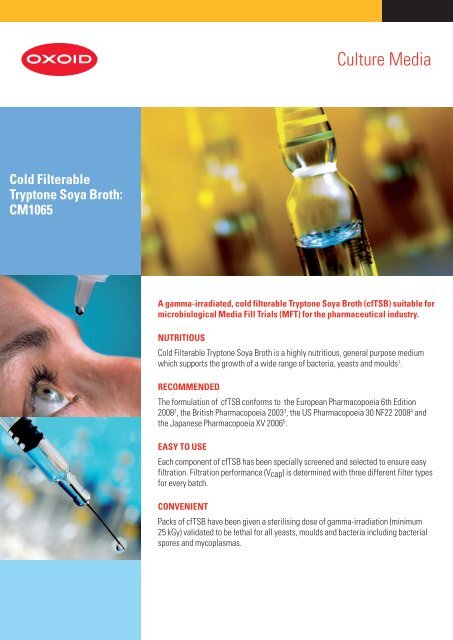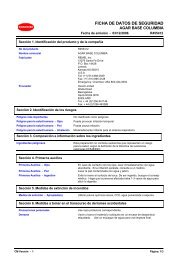product literature on cold filterable Tryptone Soya Broth - Oxoid
product literature on cold filterable Tryptone Soya Broth - Oxoid
product literature on cold filterable Tryptone Soya Broth - Oxoid
You also want an ePaper? Increase the reach of your titles
YUMPU automatically turns print PDFs into web optimized ePapers that Google loves.
Cold Filterable<br />
Trypt<strong>on</strong>e <strong>Soya</strong> <strong>Broth</strong>:<br />
CM1065<br />
Culture Media<br />
A gamma-irradiated, <strong>cold</strong> <strong>filterable</strong> Trypt<strong>on</strong>e <strong>Soya</strong> <strong>Broth</strong> (cfTSB) suitable for<br />
microbiological Media Fill Trials (MFT) for the pharmaceutical industry.<br />
NUTRITIOUS<br />
Cold Filterable Trypt<strong>on</strong>e <strong>Soya</strong> <strong>Broth</strong> is a highly nutritious, general purpose medium<br />
which supports the growth of a wide range of bacteria, yeasts and moulds1 .<br />
RECOMMENDED<br />
The formulati<strong>on</strong> of cfTSB c<strong>on</strong>forms to the European Pharmacopoeia 6th Editi<strong>on</strong><br />
2008 2 , the British Pharmacopoeia 2003 3 , the US Pharmacopoeia 30 NF22 2008 4 and<br />
the Japanese Pharmacopoeia XV 2006 5 .<br />
EASY TO USE<br />
Each comp<strong>on</strong>ent of cfTSB has been specially screened and selected to ensure easy<br />
filtrati<strong>on</strong>. Filtrati<strong>on</strong> performance (Vcap) is determined with three different filter types<br />
for every batch.<br />
CONVENIENT<br />
Packs of cfTSB have been given a sterilising dose of gamma-irradiati<strong>on</strong> (minimum<br />
25 kGy) validated to be lethal for all yeasts, moulds and bacteria including bacterial<br />
spores and mycoplasmas.
Cold Filterable Trypt<strong>on</strong>e<br />
<strong>Soya</strong> <strong>Broth</strong>: CM1065<br />
Principles<br />
<strong>Oxoid</strong> pre-screen and select the raw materials that go into cfTSB so that every<br />
batch of <str<strong>on</strong>g>product</str<strong>on</strong>g> will have a high Vcap value. Vcap is the theoretical maximum<br />
volumetric throughput for the filter under test. With this informati<strong>on</strong>, the<br />
maximum <strong>filterable</strong> volume of TSB may be calculated before starting a MFT 7 .<br />
At <strong>Oxoid</strong>, a filter management system is used with a test filters to determine<br />
Vcap values for each batch of cfTSB. The final <strong>filterable</strong> volume of TSB will<br />
depend <strong>on</strong> the membrane type, pore size and area of the process filter used.<br />
Each batch of <strong>Oxoid</strong> cfTSB will have a minimum Vcap of 2,800 litres/m 2 for the<br />
three filter types tested (0.2µm pore size).<br />
DEDICATED TO MICROBIOLOGY<br />
Part of Thermo Fisher Scientifi c<br />
†<br />
Typical Vcap values for <strong>Oxoid</strong> cfTSB:<br />
Filter membrane Vcap (ml)<br />
47mm disc<br />
Vcap is the extrapolati<strong>on</strong> to a “flow = zero” point; the time to this point may be<br />
very l<strong>on</strong>g. Therefore, Vcap is good for comparative analysis but is not practical<br />
for MFT where time for a process is limited. A more useful value is V90, which<br />
is calculated as 68% of Vcap and is the point at which flow has decayed to<br />
10% of the initial rate7 . C<strong>on</strong>tact your filter manufacturer for guidance.<br />
N.B. cfTSB should not be used to validate the suitability of the chosen filtrati<strong>on</strong><br />
system for its ability to provide a sterile drug <str<strong>on</strong>g>product</str<strong>on</strong>g>. The comp<strong>on</strong>ents of TSB<br />
will be quite different to those found in an aqueous drug formulati<strong>on</strong>, and<br />
validati<strong>on</strong> for this purpose should be carried out <strong>on</strong> the drug preparati<strong>on</strong> itself.<br />
Summary<br />
‘Sterile for use’ liquid drugs often c<strong>on</strong>tain heat-sensitive comp<strong>on</strong>ents which<br />
mean that terminal sterilisati<strong>on</strong> by autoclaving is not an opti<strong>on</strong>. Sterilisati<strong>on</strong> by<br />
filtering (for soluble liquids) followed by filling under aseptic c<strong>on</strong>diti<strong>on</strong>s is the<br />
method for preparati<strong>on</strong> of these types of drug. The purpose of MFT is to provide a<br />
measure of the likelihood of microbiological c<strong>on</strong>taminati<strong>on</strong> arising in a particular<br />
aseptic process. Typically, the compositi<strong>on</strong> of a liquid injectable drug means that<br />
that a very large volume can be filtered before blocking of that filter occurs. Due<br />
to the biological nature of TSB, filters will block so<strong>on</strong>er which will mean that the<br />
medium will have to be heated or filters changed during a MFT.<br />
Formula<br />
cfTSB (CM1065)<br />
(area 14cm 2 )<br />
Intended Use<br />
This medium is particularly suitable for use in pharmaceutical Media Fill Trials<br />
(MFT). Dehydrated cfTSB can be substituted for the powdered comp<strong>on</strong>ents that go<br />
into making aqueous injectable drugs or added as a sterile liquid downstream of<br />
processing a placebo for solid dosage form. After carrying out MFT, the medium is<br />
incubated under appropriate c<strong>on</strong>diti<strong>on</strong>s for the recovery of any bacteria, yeasts and<br />
moulds.<br />
Vcap<br />
(litres/m 2 )<br />
Polyvinylidene fluoride (PVDF) 4,909 3,506<br />
Polyethersulf<strong>on</strong>e (PES) 6,700 4,786<br />
Nyl<strong>on</strong> (NR) 4,561 3,258<br />
Grams per litre<br />
Pancreatic digest of casein 17.0<br />
Papaic digest of soybean meal 3.0<br />
Sodium chloride 5.0<br />
Di-potassium hydrogen phosphate 2.5<br />
Glucose 2.5<br />
Final pH 7.3 ± 0.2 at 25°C<br />
<strong>Oxoid</strong>, Wade Road, Basingstoke,<br />
Hants, RG24 8PW, UK<br />
The ATCC Licensed Derivative Emblem ® , the ATCC Licensed Derivative word mark ® , and the ATCC catalog marks are trademarks of ATCC.<br />
<strong>Oxoid</strong> Ltd is licensed to use these trademarks and sell <str<strong>on</strong>g>product</str<strong>on</strong>g>s derived from ATCC ® cultures.<br />
Directi<strong>on</strong>s<br />
Add 30g of cfTSB to 1 litre of distilled water. Mix well to dissolve completely.<br />
Sterilise by filtrati<strong>on</strong> or by autoclaving at 121°C for 15 minutes.<br />
Incubati<strong>on</strong> of MFT units is usually carried out for 14 days 6 at both 20-25°C and<br />
30-35°C. Where possible, visual inspecti<strong>on</strong> of the units should be carried out<br />
<strong>on</strong> a daily or every sec<strong>on</strong>d day basis. Micro-organisms from any c<strong>on</strong>taminated<br />
units should be subcultured, purified and identified to species level. Refer to the<br />
appropriate regulatory body for full guidelines 2,3,4,5 .<br />
Appearance<br />
Dehydrated medium: straw coloured, free-flowing powder<br />
Prepared medium: straw coloured soluti<strong>on</strong><br />
Precauti<strong>on</strong>s<br />
Do not use bey<strong>on</strong>d the stated expiry date, or if the <str<strong>on</strong>g>product</str<strong>on</strong>g> shows any sign of<br />
deteriorati<strong>on</strong>.<br />
Storage and Stability<br />
Dehydrated cfTSB must be stored tightly capped in the original c<strong>on</strong>tainer at<br />
10-30°C. When stored as directed, the unopened <str<strong>on</strong>g>product</str<strong>on</strong>g> will remain stable<br />
until the expiry date printed <strong>on</strong> the c<strong>on</strong>tainer.<br />
Material Safety Data Sheet (MSDS) and Batch Quality C<strong>on</strong>trol Certificates are<br />
available from the <strong>Oxoid</strong> website: www.oxoid.com.<br />
Quality C<strong>on</strong>trol Testing<br />
Organism Culti-Loops <br />
order code<br />
Staphylococcus aureus<br />
ATCC ® 6538 †<br />
Pseudom<strong>on</strong>as aeruginosa<br />
ATCC ® 9027 †<br />
Bacillus subtilis<br />
ATCC ® 6633 †<br />
Aspergillus brasiliensis<br />
ATCC ® 16404 †<br />
Candida albicans<br />
ATCC ® 10231 †<br />
References<br />
1. <strong>Oxoid</strong> Manual 8th Editi<strong>on</strong>, 1998, p2-208 2. European Pharmacopoeia 6th Editi<strong>on</strong> 2008 3. British Pharmacopoeia 2008<br />
4. US Pharmacopoeia 30 NF22 2008 5. Japanese Pharmacopoeia XV 2006 6. Microbiological Media Fills Explained by<br />
Nigel Halls, 2002. Sue Horwood Publishing Ltd., UK. 7. Badmingt<strong>on</strong>, F., Wilkins, R., Payne, M. and H<strong>on</strong>ig, E.S. Vmax<br />
Testing for Practical Microfiltrati<strong>on</strong> Train Scale-Up in Biopharmaceutical Processing Pharmaceutical Technology<br />
September 1995 p64-76<br />
Tel: +44 (0) 1256 841144<br />
Fax: +44 (0) 1256 329728<br />
Email: oxoid.info@thermofi sher.com<br />
Typical<br />
appearance<br />
C7016L Turbid growth<br />
C5210L Turbid growth<br />
C1221L Flocculent/surface<br />
growth<br />
C1100L White mycelia, black<br />
spores or no spores<br />
C1503L Flocculent/surface<br />
growth<br />
Un-inoculated medium N/A No growth<br />
www.oxoid.com<br />
www.thermofi sher.com<br />
© 2008, <strong>Oxoid</strong> Ltd.; copyrights to photographs held separately; c<strong>on</strong>tact <strong>Oxoid</strong> Ltd. for details. Photographs may not be extracted or reproduced in any way. Folio No 1023/MS/12/08
















